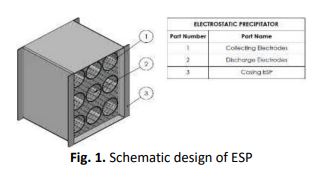Performance of Electrostatic Precipitator as Air Cleaner in Water Production Process from Humid Air
DOI:
https://doi.org/10.37934/arfmts.91.1.129139Keywords:
Electrostatic precipitator, particle collection efficiency, humid air, atmospheric water maker, water qualityAbstract
Humid air as a source of water can be utilized by using a condensation system called the Atmospheric Water Maker (AWM) in order to overcome the problem of limited drinking water supply. However, to maintain water quality and production capacity, the AWM requires an air filtration system with minimum flow resistance. In this work, an electrostatic precipitator (ESP) was used as an air filter for AWM application. Thus, this study aimed to investigate the performance of ESP in terms of particle collection efficiency and water quality produced by AWM. In order to evaluate the performance of ESP, wire to cylinder type ESP was designed and three experimental activities were performed i.e., smoke filtration test, dust filtration experiment, and AWM water quality assessment. The performance of ESP was studied at various voltages ranging from 5.8 kV to 9.7 kV and two wire mesh sizes. The results showed soot particles were successfully removed by the ESP for all applied voltages with both 1 mm and 4 mm wire mesh. The effect of ESP voltage could be observed in dust filtration experiments in which the particle collection efficiency increases with the increase of voltage. The highest particle collection efficiency was observed at a voltage of 9.7 kV with a wire mesh of 1 mm. The results also showed that the use of ESP for AWM application offered a positive effect on the quality of condensed water in which the water physical and chemical properties satisfy the WHO standard for drinking water.
Downloads






























